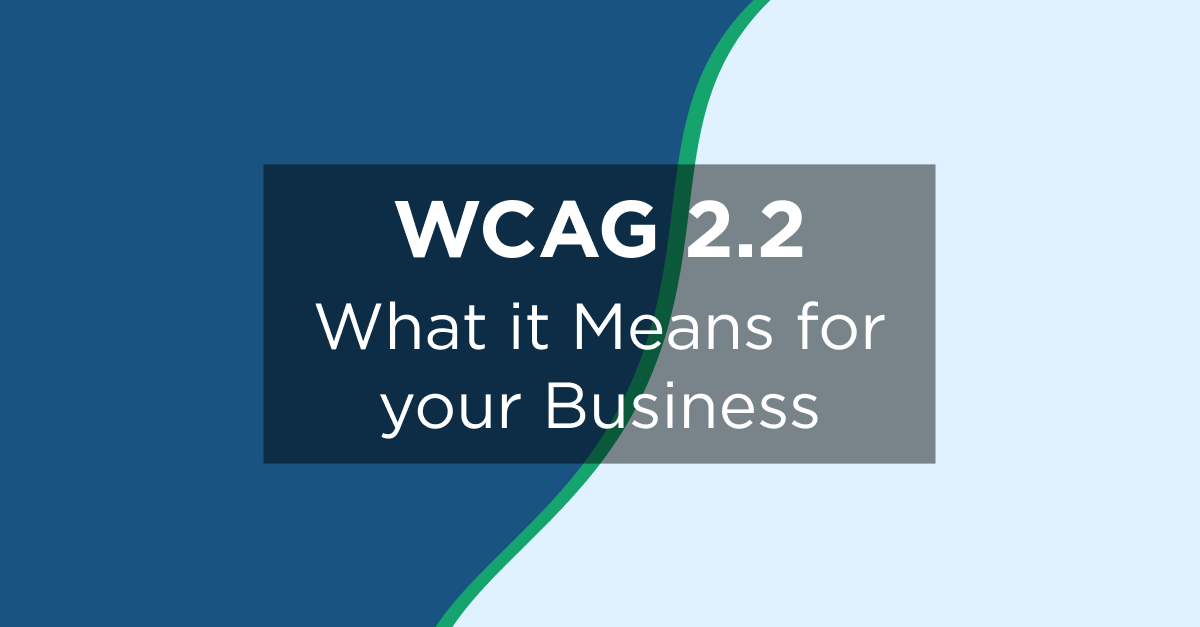WCAG 2.2, the latest update to the Web Content Accessibility Guidelines, introduces new success criteria designed to improve digital accessibility and usability for people with disabilities. In this guide, we break down what’s new in WCAG 2.2, how it affects compliance, and what organizations need to do to meet the updated standards.
Article Contents
- Why the Change to WCAG 2.2?
- Differences between WCAG 2.2 and Previous Standards
- Why Adopt WCAG 2.2 Recommendations?
- WCAG 2.2 FAQs
This blog was originally published in October 2023 and updated in April 2024.
WCAG 2.2 is here!
After several delays, the most recent version of the Web Content Accessibility Guidelines (WCAG) was announced yesterday, October 5, 2023.
For those unfamiliar, the Web Content Accessibility Guidelines (WCAG) are the widely accepted industry benchmark for website accessibility, provided by the W3C Web Accessibility Initiative (WAI). Before introducing WCAG 2.2, the W3C provided the WCAG 2.1 conformance level in June of 2018, which expanded on the preceding 2.0 level.
UsableNet has been tracking the updated 2.2 guidelines and preparing our technology and services to support them. Now that it's officially a W3C standard, the WCAG 2.2 conformance level is an option for all our approaches to accessibility.
We've also answered your top questions about WCAG 2.2 in a separate post.
This blog covers what we know about the new WCAG 2.2 and what to consider before adopting it as your accessibility standard.
Interested in hearing accessibility experts speak more on this topic? Watch a new on-demand webinar: Mastering WCAG 2.2 AA," a special presentation tailored to developers and designers delivered by UsableNet's Accessibility Experts. Register here to watch on-demand now.
Why the Change to WCAG 2.2?
In short, the W3C developed WCAG 2.2 to enhance the web experience for users from the disability community. The guidelines provide updated, specific criteria for making your digital content accessible.
The new WCAG 2.2 guidelines cover many disabilities, including visual, auditory, physical, speech, cognitive, language, learning, and neurological disabilities. The guidelines extended requirements for users with low vision, cognitive impairments, and limited fine motor skills.
Companies that adopt the new standard will find that WCAG 2.2 improves the web experience for all users. WCAG 2.2 will become the industry standard due to 9 additional usability and accessibility considerations.
Differences between WCAG 2.2 and Previous Standards
Requirements from both WCAG 2.1 and 2.0 have been integrated into 2.2, allowing you to build upon the accessibility progress you've already made. 2.2 uses the same A / AA / AAA conformance levels seen in WCAG 2.0 AND 2.1.
But past accessibility guidelines like WCAG 2.0 overlooked mobile accessibility. Not until WCAG 2.1 became the new accessibility standard in June 2018 was a strong emphasis put on the mobile experience.
Now, with the introduction of WCAG 2.2, the guidelines address the accessibility of web content on desktops, laptops, tablets, and mobile devices.
The 9 success criteria that are new in WCAG 2.2:
2.4.11 Focus Not Obscured (Minimum)(AA)

Overview of WCAG 2.4.11 - Focus Not Obscured (Minimum)
Success Criteria 2.4.11 Focused Not Obscured (Minimum) is the following:
When a user interface component receives keyboard focus, the component is not entirely hidden due to author-created content.
2.4.12 Focus Not Obscured (Enhanced) (AAA)
Success Criteria 2.4.12 Focused Not Obscured (Enhance) is the following:
When a user interface component receives keyboard focus, the component is completely visible on the screen.
2.4.13 Focus Appearance (AAA)
Success Criteria 2.4.3 Focus Appearance passes when the focus indicator is visible, is large enough, and has enough contrast.
2.5.7 Dragging Movements (AA)

Overview of WCAG 2.5.7 - Dragging Movements
Success Criteria 2.5.7 Dragging Movements is the following:
All functionality that uses a dragging movement for operation can be achieved by a single pointer without dragging, unless dragging is essential or the functionality is determined by the user agent and not modified by the author
2.5.8 Target Size (Minimum) (AA)

Overview of WCAG 2.5.8 - Target Size (Minimum)
Success Criteria 2.5.8 Target Size (Minimum) is the following:
The size of the target for pointer inputs is at least 24 by 24 CSS pixels, except where:
- Spacing: Undersized targets (those less than 24 by 24 CSS Pixels) are positioned so that if a 24 CSS pixel diameter circle is centered on the bounding box of each, the circles do not intersect another target or the circle for another undersized target
- Equivalent: The function can be achieved through a different control on the same page that meets this criterion
- Inline: The target is in a sentence or its size is otherwise constrained by the line-height of non-target text
- User-agent control: The size of the target is determined by the user agent and is not modified by the author
- Essential: A particular presentation of the target is essential or is legally required for the information being conveyed
3.2.6 Consistent Help (A)

Overview of WCAG 3.2.6 - Consistent Help
Success Criteria 3.2.6 Consistent Help is the following:
If a web page contains any of the following help mechanisms, and those mechanisms are repeated on multiple web pages within a set of web pages, they occur in the same order relative to other page content, unless a change is initiated by the user:
- Human contact details
- Human contact mechanism
- Self-help option
- A fully automated contact mechanism
3.3.7 Redundant Entry (A)

Overview of WCAG 3.3.7 - Redundant Entry
Success Criteria 3.3.7 Redundant Entry is the following:
Information previously entered by or provided to the user that is required to be entered again in the same process is either:
- Auto-populated
- Available for the user to select
Except when
- Re-entering the information is essential
- The information is required to ensure the security of the content
- The previously entered information is no longer valid
3.3.8 Accessible Authentication (Minimum) (AA)

Overview of WCAG 3.3.8 - Accessible Authentication (Minimum)
Success Criteria 3.3.8 Accessible Authentication (Minimum) is the following:
A cognitive function test (such as remembering a password or solving a puzzle) is not required for any step in an authentication process unless that step provides at least one of the following:
- Alternative: Another authentication method that does not rely on a cognitive test
- Mechanism: A mechanism is available to assist the user in completing the cognitive function test
- Object Recognition: The cognitive function test is to recognize objects
- Personal Content: The cognitive function test is to identify non-text content the user provided to the website
3.3.9 Accessible Authentication (Enhanced) (AAA)
Success Criteria 3.3.9 Accessible Authentication (Enhanced) Only includes the Alternative and Mechanism cognitive functions from Success Criteria 3.3.8 as valid authentication methods.
WCAG 2.2 has also been removed one success criterion present in 2.1:
- 4.1.1 Parsing (A)
Why Adopt WCAG 2.2 Recommendations?
The WCAG 2.2 guidelines represent the most up-to-date and comprehensive accessibility standards available. Since WCAG 2.2 considers a broad spectrum of disabilities and technologies, it is poised to become the prevailing standard.
In addition to improving accessibility and usability, adopting WCAG 2.2 provides a more inclusive, consistent, and user-friendly experience for everyone who engages with your brand—across desktop, mobile, and assistive technologies.
It's worth emphasizing that WCAG 2.0 and WCAG 2.1 are still W3C recommendations. However, here are a few reasons why and when you might consider making WCAG 2.2 your accessibility standard:
1. Comply with Future Accessibility Regulations
If you conform to WCAG 2.2, you will be in excellent shape to comply with future digital accessibility regulations.
2. Improve Your Current Accessibility
Adopting WCAG 2.2 is the best way to ensure your content is accessible to the broadest range of people across technologies.
3. Reduce Your Risk of Legal Action
ADA legal complaints often reference WCAG. And for now, ADA-based digital accessibility lawsuits will likely continue referencing WCAG 2.1 AA.
However, adopting WCAG 2.2 is the safest bet to protect your business from digital accessibility lawsuits. Plaintiffs will likely begin to point to WCAG 2.2 as the standard for remediation.
4. Show Your Support for the Disability Community
Moving toward WCAG 2.2 accessibility before others in your industry and before it becomes a legal requirement is an excellent way to demonstrate your company's commitment to accessibility, diversity, equity, and inclusion.
Actions speak louder than words, and the disability community is a large, loyal community that takes notice of actions.
Ultimately, adopting WCAG 2.2 is one of the most effective ways to future-proof your accessibility efforts, improve usability for all users, and demonstrate inclusive values in a tangible, measurable way.
Learn more about WCAG 2.2 AA and get your questions answered by our accessibility experts. Register to watch our webinar on-demand now
If you're unsure which accessibility standard makes sense, contact UsableNet. We can book a 15-minute consultation to learn about your goals and help advise you on the best next step in your accessibility journey. Book now.
WCAG 2.2 FAQs
What’s new in WCAG 2.2?
WCAG 2.2 introduces new success criteria addressing issues like accessible authentication, clearer focus indicators, reduced cognitive load, and improved touch-target size. These updates help expand accessibility coverage for users with cognitive impairments, limited fine-motor skills, and low vision.
Is WCAG 2.2 required for compliance?
WCAG 2.2 is not yet mandated by all laws or regulations, but it is a W3C recommendation and is expected to inform future accessibility requirements. Adopting WCAG 2.2 now positions organizations ahead of emerging legal obligations and reduces risk in ADA-related digital accessibility cases.
Does WCAG 2.2 replace WCAG 2.0 and 2.1?
WCAG 2.0 and 2.1 remain valid W3C recommendations, but WCAG 2.2 is the most up-to-date standard. Organizations focused on long-term compliance and user experience are encouraged to adopt WCAG 2.2 to stay aligned with evolving industry expectations.
How can my business prepare for WCAG 2.2 compliance?
Start by reviewing the nine new success criteria and assessing which apply to your site or application. Many organizations begin with accessibility audits, updated remediation roadmaps, and continuous testing with both automated and manual methods, including testing by users with disabilities.










